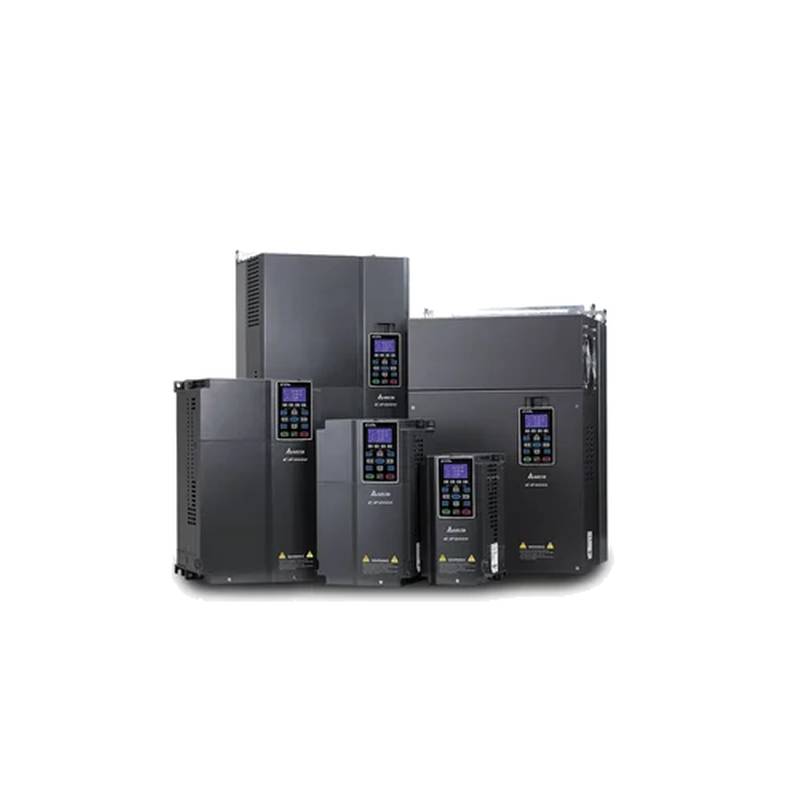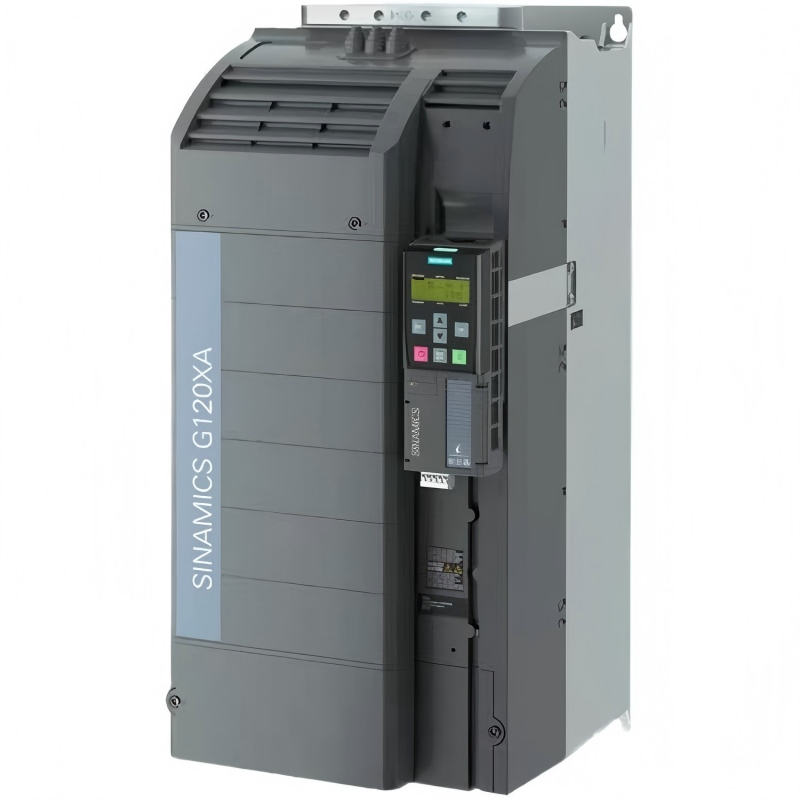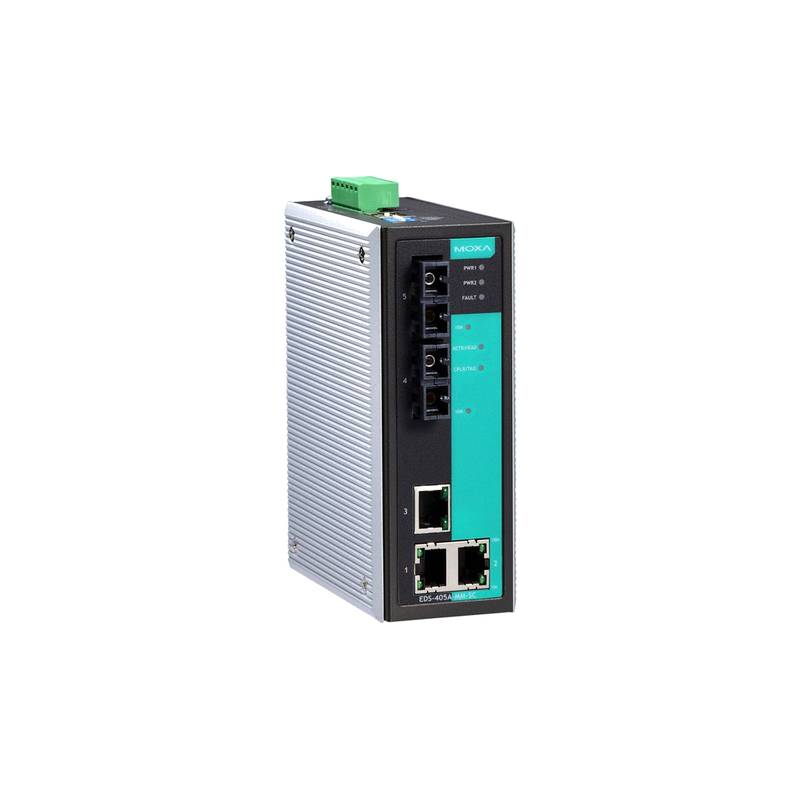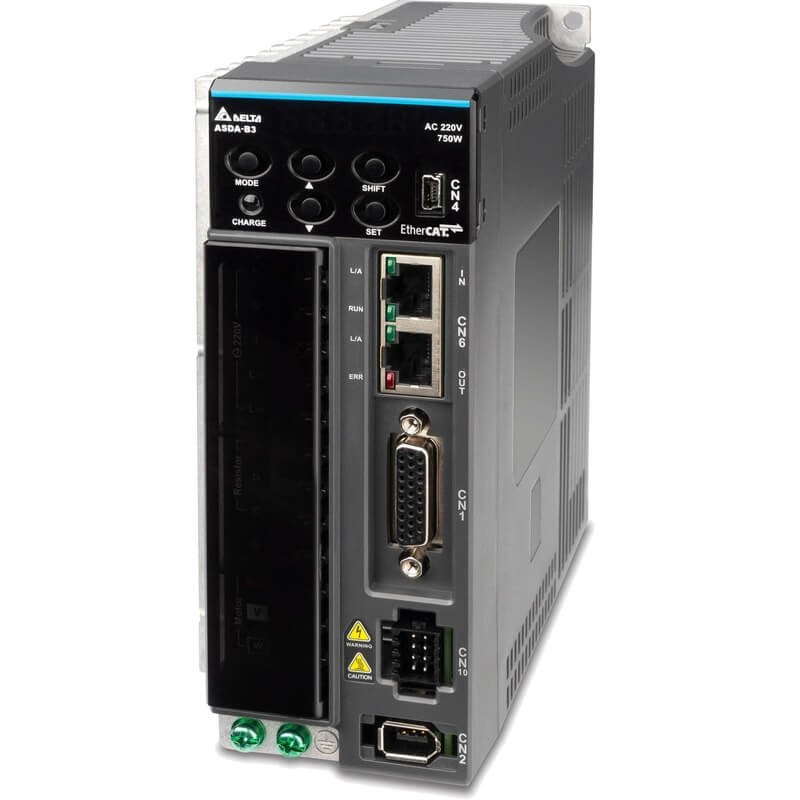
The Delta VFD1850CP43B-21, a CP2000 Standard Model Inverter, stands out in the industrial automation landscape with its robust performance and advanced capabilities. This 370A, 185kW unit delivers exceptional control for a wide array of motor applications. Key advantages include its high efficiency, superior motor control algorithms, and comprehensive protection features. Core technical parameters highlight its 185kW power rating, 370A output current, and compatibility with 400V (430V Class) power systems. Its modular design and user-friendly interface further enhance its appeal for demanding industrial environments seeking reliable and precise motor management solutions.
Product Specifications
| Parameter | Specification |
| :------------------ | :------------------------------------------------ |
| Model | VFD1850CP43B-21 (CP2000 Standard Model) |
| Rated Power | 185 kW (250 HP) |
| Output Current | 370 A |
| Input Voltage Class | 400V Class (3-Phase, 50/60Hz) |
| Output Voltage | 3 Phase, 0-460V |
| Control Method | Sensorless Vector Control, V/f Control |
| Protection | Overload, Overvoltage, Undervoltage, Short Circuit, Overheat, etc. |
| Communication | Built-in RS-485 (Modbus RTU), Optional fieldbus cards |
| Operating Temperature| -20°C to +50°C (derating may apply above 40°C) |
| Enclosure | IP20 |
Core Features & Market Positioning
The Delta VFD1850CP43B-21 distinguishes itself through its advanced control technologies, including sophisticated sensorless vector control, which provides precise torque and speed regulation even under varying load conditions. This capability positions it as a superior choice for applications demanding high accuracy and dynamic response, such as in material handling, textile machinery, and pump/fan control where energy efficiency is paramount. The CP2000 series is known for its robust design and long-term reliability, making it a cost-effective solution for industries seeking to minimize downtime and maintenance. Its competitive advantage lies in balancing high performance with ease of use and integration.
Key Application Scenarios
This 185kW inverter is ideally suited for a broad spectrum of heavy-duty industrial applications. Its powerful 370A output makes it a prime candidate for driving large pumps and fans in water treatment plants, HVAC systems, and industrial ventilation, where precise flow control and energy savings are critical. In the manufacturing sector, the VFD1850CP43B-21 excels in applications such as conveyor systems, extruders, and mixers, providing the necessary torque and speed control for continuous and demanding production processes. Its versatility also extends to cranes, hoists, and other material handling equipment, offering smooth acceleration, deceleration, and precise positioning.
Practical System Integration Guidance
Integrating the Delta VFD1850CP43B-21 into existing systems is streamlined due to its flexible communication options and straightforward wiring. For installation, ensure adequate ventilation and adhere to local electrical codes, mounting the inverter vertically in a clean, dry environment. Wiring involves connecting the main power input to L1, L2, L3, and the motor leads to T1, T2, T3. Safety grounds must be properly connected. Parameter configuration is typically accessed via the front panel keypad or through Delta's Drive PC Software. Essential parameters to set initially include motor nameplate data, desired control mode (e.g., sensorless vector), and relevant protection limits to match the application's requirements. For communication integration, utilize the built-in RS-485 port with Modbus RTU protocol or install an optional communication card compatible with prevalent industrial networks like Profibus or EtherNet/IP.
Operation and Risk Mitigation
Safe operation of the Delta VFD1850CP43B-21 relies on understanding its protection mechanisms and adhering to operational guidelines. The inverter features comprehensive built-in protections against overcurrent, overvoltage, undervoltage, phase loss, overload, and overheating, which automatically halt operation to prevent damage. Users should familiarize themselves with common fault codes displayed on the HMI to quickly diagnose issues; for example, an 'OL' (Overload) fault indicates the motor is drawing too much current, often due to mechanical issues or undersized motor, while an 'E. OV' (Overvoltage) fault suggests potential issues with regenerative braking or grid instability. Always ensure the drive is properly grounded and that emergency stop circuits are correctly wired to a designated digital input for immediate shutdown capability. Periodic inspection of wiring and cooling fan functionality is crucial for maintaining optimal performance and preventing unexpected shutdowns.
Scalability & Long-Term Value
The Delta VFD1850CP43B-21 offers significant scalability and long-term value through its modular design and compatibility with Delta's broader automation ecosystem. Its ability to integrate with PLCs, HMIs, and other control devices via various communication protocols ensures it can be a central component in sophisticated automation systems. For future upgrades or expansion, the CP2000 series supports optional communication cards, allowing seamless integration into IIoT platforms and advanced manufacturing environments, enabling predictive maintenance and remote monitoring capabilities. This forward-thinking design ensures that investments in Delta VFD technology remain relevant and enhance operational efficiency over the product's lifespan.
Frequently Asked Questions
1. What is the primary advantage of sensorless vector control in this inverter?
Sensorless vector control allows for precise motor speed and torque regulation. It achieves this without requiring external motor encoders. This leads to excellent dynamic performance.
It adapts dynamically to load variations, ensuring consistent operation. This is crucial for applications needing high accuracy. It also contributes to improved energy efficiency.
This control method offers a cost-effective solution for demanding applications. It removes the need for additional expensive sensors. It simplifies installation and reduces potential failure points.
2. How do I perform basic parameter setup for the VFD1850CP43B-21?
Start by entering motor nameplate data. This includes voltage, current, frequency, and RPM. This step is vital for optimal performance.
Next, select the control mode. Sensorless vector control is recommended for dynamic loads. V/f control is simpler for basic applications. Set acceleration and deceleration times.
Finally, configure essential protection parameters. Set overload limits based on motor capacity. Configure digital inputs for start/stop and speed selection. Ensure safety interlocks are programmed.
3. What are common causes for an 'OL' fault on the Delta VFD1850CP43B-21?
An 'OL' fault indicates the inverter has detected an overload condition. This means the motor is drawing more current than it can safely handle. It's a protective measure to prevent damage.
Common causes include mechanical issues. This could be friction in the driven equipment, undersized motor, or a jam. It can also result from incorrect parameter settings.
Verify motor nameplate data matches settings. Check for excessive starting torque demands. Ensure the motor and driven load are properly sized for the application.
4. Can this inverter be integrated into a Profibus network?
Yes, the Delta VFD1850CP43B-21 supports integration into Profibus networks. This requires an optional communication option card. The card is installed in the inverter's expansion slot.
Once the Profibus card is installed, network configuration is needed. This involves assigning a Profibus address to the drive. Parameter settings within the inverter will be adjusted to communicate via Profibus.
Integration allows for centralized control and monitoring. You can exchange data like speed commands, status feedback, and fault information. This enhances automation capabilities.
5. What is the maximum ambient operating temperature for this inverter?
The VFD1850CP43B-21 has a rated ambient operating temperature range. It can typically operate from -20°C to +50°C. However, derating may be necessary.
For temperatures above 40°C, the inverter's output current capability is reduced. This derating ensures the inverter's internal components remain within safe thermal limits. Always consult the manual for specific derating curves.
Proper ventilation is crucial, especially at higher temperatures. Ensure adequate airflow around the inverter to dissipate heat effectively. Overheating can lead to performance degradation and premature failure.
6. How do I wire the main power supply to the VFD1850CP43B-21?
Ensure the power supply is disconnected before wiring. Connect the three-phase AC input power to the L1, L2, and L3 terminals. These are clearly marked on the inverter.
It is essential to connect the ground terminal. This is typically marked with a ground symbol. Proper grounding is critical for safety and to prevent electrical noise.
Double-check all connections for tightness. Incorrect wiring can lead to serious damage or safety hazards. Refer to the VFD1850CP43B-21 manual for precise wiring diagrams.
7. What is the significance of the 'E. OV' fault code?
The 'E. OV' fault code signifies an overvoltage condition. This means the DC bus voltage inside the inverter has exceeded its safe operating limit. It's a protective shutdown.
This can occur during deceleration if the motor is generating power. This regenerative energy is typically absorbed by braking resistors. If the energy is too high or resistors are absent, voltage rises.
Check for issues with braking resistors or external braking units. Grid voltage fluctuations can also contribute. Parameter settings related to braking control may need adjustment.
8. Does this inverter support Modbus RTU communication?
Yes, the Delta VFD1850CP43B-21 comes with a built-in RS-485 port. This port natively supports the Modbus RTU communication protocol. This is standard for many industrial automation systems.
Modbus RTU enables communication with PLCs and SCADA systems. You can exchange data such as speed commands, status readings, and fault diagnostics. It's a widely adopted and reliable protocol.
Configuration involves setting the communication address, baud rate, and parity. These settings must match the master device on the network. Refer to the manual for detailed communication parameter settings.
9. What are the typical applications for a 185kW inverter?
A 185kW inverter is suitable for high-power industrial applications. This includes driving large pumps and fans in sectors like water treatment and HVAC. It's also used for industrial ventilation systems.
In manufacturing, it's ideal for large extruders, mixers, and crushers. It provides the necessary torque for demanding continuous processes. Material handling equipment like large conveyors also benefits.
Its capacity makes it suitable for compressors and large industrial machinery. Applications requiring significant starting torque and precise speed control are well-suited.
10. How does the enclosure rating (IP20) affect installation?
An IP20 enclosure rating means the inverter is protected against solid objects larger than 12.5mm. It offers limited protection against water ingress. It is not suitable for dusty or wet environments without additional protection.
Therefore, the VFD1850CP43B-21 must be installed in a clean, dry control cabinet or enclosure. Adequate ventilation within the cabinet is essential to maintain optimal operating temperatures. It should be protected from direct contact with personnel.
This rating dictates the environment in which it can be safely operated. For harsher conditions, an external enclosure with a higher IP rating might be necessary, ensuring proper thermal management is still in place.
























